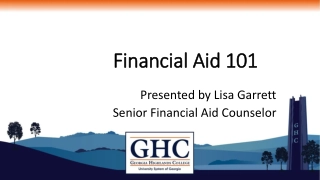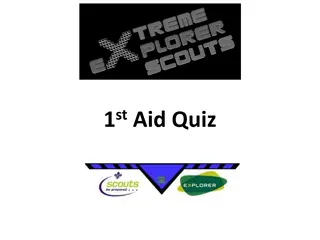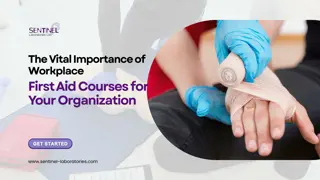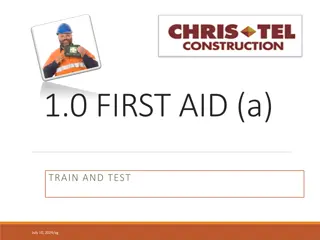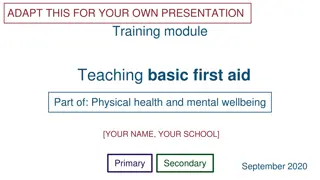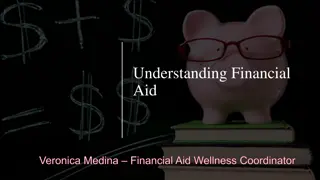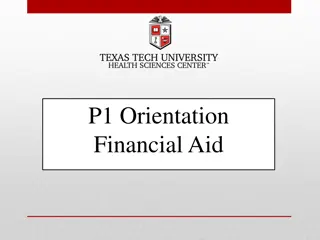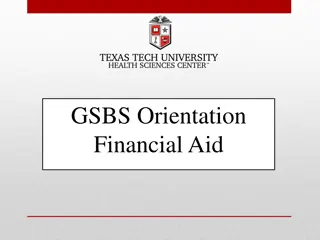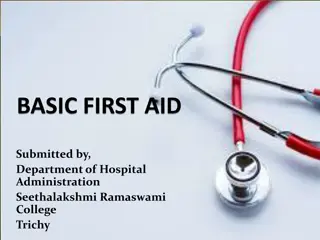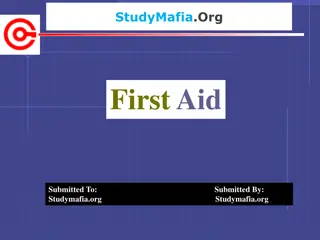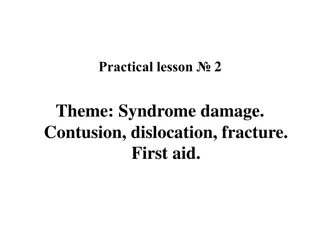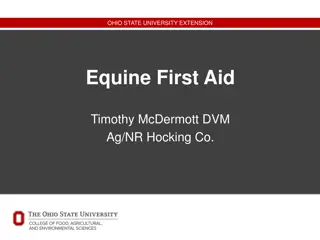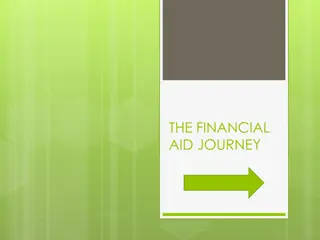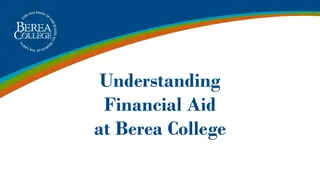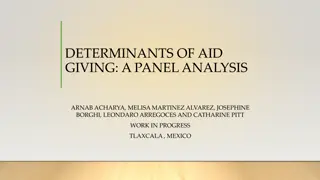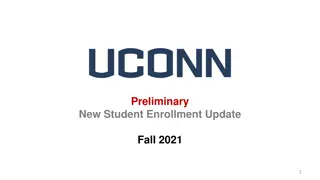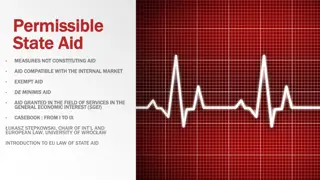Comprehensive Guide to First Aid Basics
First aid is crucial in providing emergency care until professional medical help is available. This guide covers the importance of first aid, its aims, basics, proper handwashing techniques, essential first aid kit items, and procedures for common emergencies like wounds, bleeding, and fractures. Learn how to assess situations, ensure safety, and administer immediate care effectively to save lives and reduce the severity of injuries.
Download Presentation

Please find below an Image/Link to download the presentation.
The content on the website is provided AS IS for your information and personal use only. It may not be sold, licensed, or shared on other websites without obtaining consent from the author. Download presentation by click this link. If you encounter any issues during the download, it is possible that the publisher has removed the file from their server.
E N D
Presentation Transcript
First Aid First aid refers to the emergency care provided to the person affected till medical treatment is available.
Aims of first aid 1. To save life. 2. To protect the casualty from getting more harm. 3. To reduce pain and priorities of Casualty Treatment.
First aid basics The first step in any emergency is the recognition of the problem and providing help. The next step in providing help is to determine the responsiveness of the injured or ill person. Assessing the safety of the surroundings is critical when approaching any scene. Handwashing is essential in the prevention of disease and illness. Wash your hands after each episode of care and after taking off gloves.
Proper handwashing technique Completely wet your hands and generously apply soap. Rub vigorously for at least 20 seconds Rinse your hands with plenty of running water. Dry your hands with a towel or air dryer.
First aid kit Bandages, roller bandages, and tape Sterile gauze Antiseptic wipes and swabs Antibiotic cream Burn ointment Mask for breathing (rescue breathing/CPR) First aid reference guide that includes local phone numbers
First aid during accident Immediate requirement Critical four minutes : One of the most common causes of a road accident death is due to loss of oxygen supply. This is mostly caused by a block airway. Normally it takes less than four minutes for a blocked airway to cause death. The 'golden hour' : The first hour after the Trauma is called the 'golden hour'. If proper first aid is given, road accident victims has a greater chance of survival and a reduction in the severity of their injuries.
In case of a wound- remove the dirt, glass pieces if any or thorns on the wound carefully. Don t disturb the wound. Wash the wound in running water To stop bleeding- apply pressure on the wound. Keep a clean cloth on the wound and apply pressure In case of fracture- In case of a fracture do not apply direct pressure; instead use a splint, combined with as gentle pressure bandage. In case of chest or abdomen injury-In abdominal wounds the intestines may come out. The only thing you can do as first-aider is to cover the wound with a very wet clean cloth and get the patient quickly to a hospital. The wet cloth will keep the intestine from drying out, and will stick to the intestine.
In case a limb is cut off- If a part of the limb has been cut off it may be possible to reattach it to the body. Put it inside a clean polythene bag and place this bag in another bag with cold water. If you can easily get ice put some in the water to keep it cool. Make sure that the limb does not get soaked in water. If nothing else is available, carry the amputated part in a clean cloth quickly to hospital.
Bleeding from nose- Bleeding from nose could also mean a head injury. If the patient is conscious and can sit up, ask him to pinch his nose and breathe through his mouth. If he can lean forward, then that could prevent blood from going to his wind pipe choking him. If the patient is unconscious he should lie with the face to one side, for the blood to come out easily, so that there is no choking.
In case of ear bleeding- Bleeding from ears mean either injury to the ear alone, or serious head injury. Avoid putting anything in the ears to stop bleeding as this could further damage the eardrum. Get the patient to lie down with the injured ear facing down.
Points to keep in mind 1 Ensure that he is not hurt more. 2 The patient should be carried on firm board of stretcher so spine remains stable. While shifting, the patient's back, neck and airway need to be protected from further injury. So always take help of another person. 3 If the patient is unconscious, gently place a large folded cloth or towel under the neck so that the neck doesn't sag against the ground. 4 The vehicle used to carry the patient to the hospital should have enough space to keep the patient's back straight and the person accompanying should be able to care for and resuscitate the patients if necessary. 5 During transportation keep a watch on whether the patient's airway is clear, whether the patient is breathing and whether you can feel the pulse in the patient. 6 If there is only one limb injury the patient can be safely taken to hospital on a chair in a sitting position. Take care to splint or protect limb injuries or bleeding. 7
First aid during choking Choking happens when someone's airway suddenly gets blocked, either fully or partly, so they can't breathe.
Mild choking: encourage them to cough If the airway is only partly blocked, the person will usually be able to speak, cry, cough or breathe. They'll usually be able to clear the blockage themselves. To help with mild choking in an adult or child over 1 year old: encourage them to keep coughing to try to clear the blockage ask them to try to spit out the object if it's in their mouth don't put your fingers in their mouth to help them as they may bite you accidentally If coughing doesn't work, start back blows.
Severe choking: back blows and abdominal thrusts Where choking is severe, the person won't be able to speak, cry, cough or breathe. Without help, they'll eventually become unconscious. To carry out a back blow on an adult or child over 1 year old: Stand behind them and slightly to one side. Support their chest with 1 hand. Lean them forward so the object blocking their airway will come out of their mouth, rather than moving further down. Give up to 5 sharp blows between their shoulder blades with the heel of your hand. The heel is between the palm of your hand and your wrist. Check if the blockage has cleared. If not, give up to 5 abdominal thrusts.
Abdominal thrusts Don't give abdominal thrusts to babies under 1 year old or pregnant women. To carry out an abdominal thrust: Stand behind the person who's choking. Place your arms around their waist and bend them forward. Clench 1 fist and place it right above their belly button. Put the other hand on top of your fist and pull sharply inwards and upwards. Repeat this movement up to 5 times. If the person's airway is still blocked after trying back blows and abdominal thrusts, get help immediately:
First aid during heart attack Someone having a heart attack may have any or all of the following: Chest pain, pressure or tightness, or a squeezing or aching sensation in the center of the chest Pain or discomfort that spreads to the shoulder, arm, back, neck, jaw, teeth or occasionally upper abdomen Nausea, indigestion, heartburn or abdominal pain Shortness of breath Lightheadedness, dizziness, fainting Sweating A heart attack generally causes chest pain for more than 15 minutes. Some people have mild chest pain, while others have more-severe pain. The discomfort is commonly described as a pressure or chest heaviness, although some people have no chest pain or pressure at all. Women tend to have more-vague symptoms, such as nausea or back or jaw pain.
Some heart attacks strike suddenly, but many people have warning signs hours or days in advance.
What to do? Call your local emergency number Chew and swallow an aspirin while waiting for emergency help. Aspirin helps keep your blood from clotting. When taken during a heart attack, it could reduce heart damage. Don't take aspirin if you are allergic to it or have been told by your doctor never to take aspirin. If the person is unconscious start CPR
How to do CPR? https://www.youtube.com/watch?v=-NodDRTsV88
Burns- first aid Major burns Are deep Cause the skin to be dry and leathery May appear charred or have patches of white, brown or black Are larger than 3 inches (about 8 centimeters) in diameter or cover the hands, feet, face, groin, buttocks or a major joint
Minor burns Superficial redness similar to a sunburn Pain Blisters An area no larger than 3 inches (about 8 centimeters) in diameter
In case of burns Protect the burned person from further harm. If you can do so safely, make sure the person you're helping is not in contact with the source of the burn. For electrical burns, make sure the power source is off before you approach the burned person. Make certain that the person burned is breathing. If needed, begin rescue breathing if you know how. Remove jewelry, belts and other restrictive items, especially from around burned areas and the neck. Burned areas swell rapidly. Cover the area of the burn. Use a cool, moist bandage or a clean cloth. Don't immerse large severe burns in water. Doing so could cause a serious loss of body heat (hypothermia). Elevate the burned area. Raise the wound above heart level, if possible. Watch for signs of shock. Signs and symptoms include fainting, pale complexion or breathing in a notably shallow fashion.
Allergy It involves an exaggerated response of the immune system, often to common substances such as foods, furry animal and pollen. Anaphylaxis- life threatening allergic reaction.
Symptoms of anaphylaxis skin reactions such as hives, flushed skin, or paleness suddenly feeling too warm feeling like you have a lump in your throat or difficulty swallowing nausea, vomiting, or diarrhea abdominal pain a weak and rapid pulse runny nose and sneezing swollen tongue or lips wheezing or difficulty breathing a sense that something is wrong with your body tingling hands, feet, mouth, or scalp
First Aid 1.Call hospital 2.See if they have an epinephrine (adrenaline) auto-injector (EpiPen) and help them, if needed. 3.Try to keep the person calm. 4.Help the person lie on their back. 5.Raise their feet about 12 inches and cover them with a blanket. 6.Turn them on their side if they re vomiting or bleeding. 7.Make sure their clothing is loose so they can breathe.



